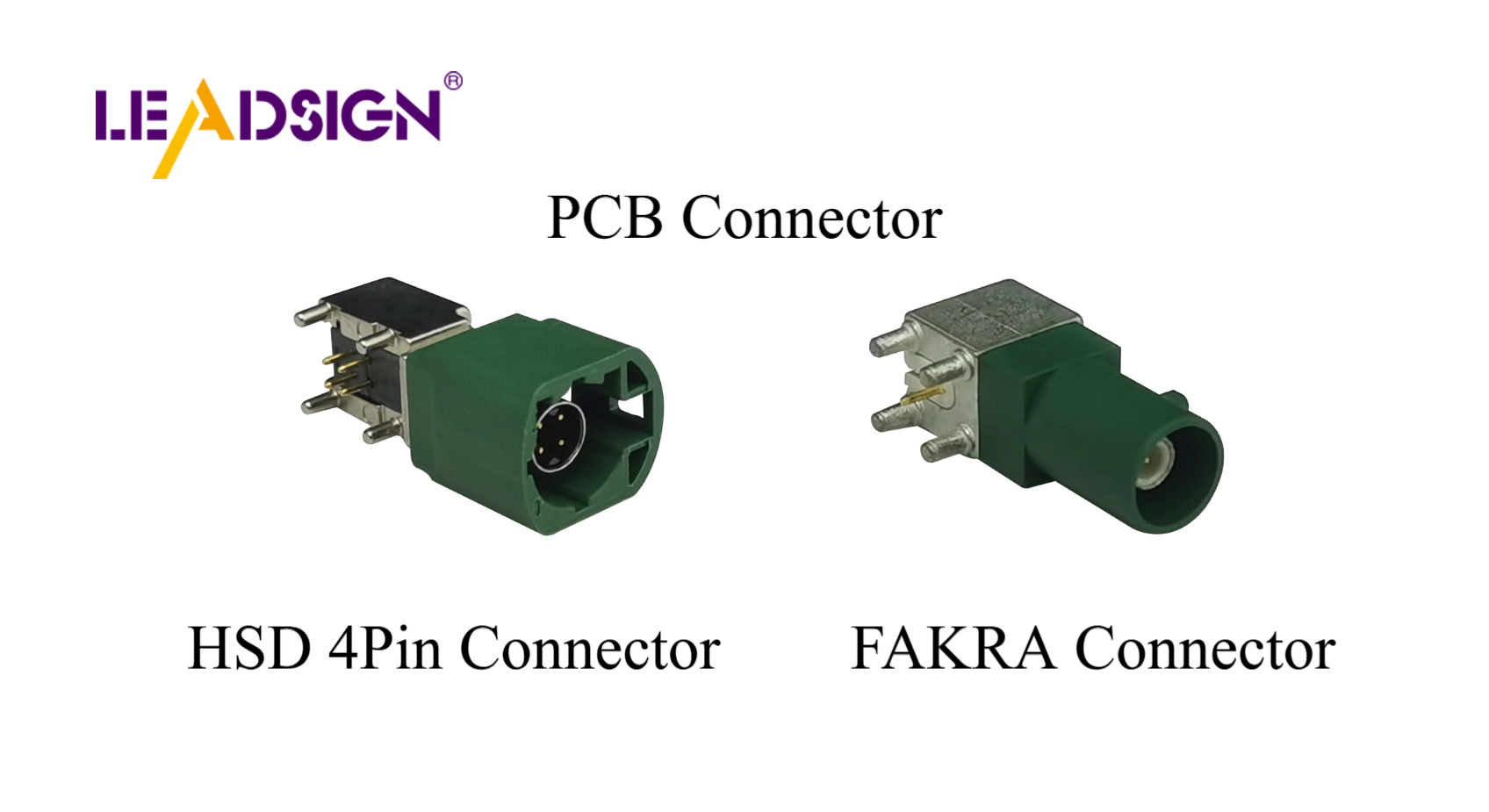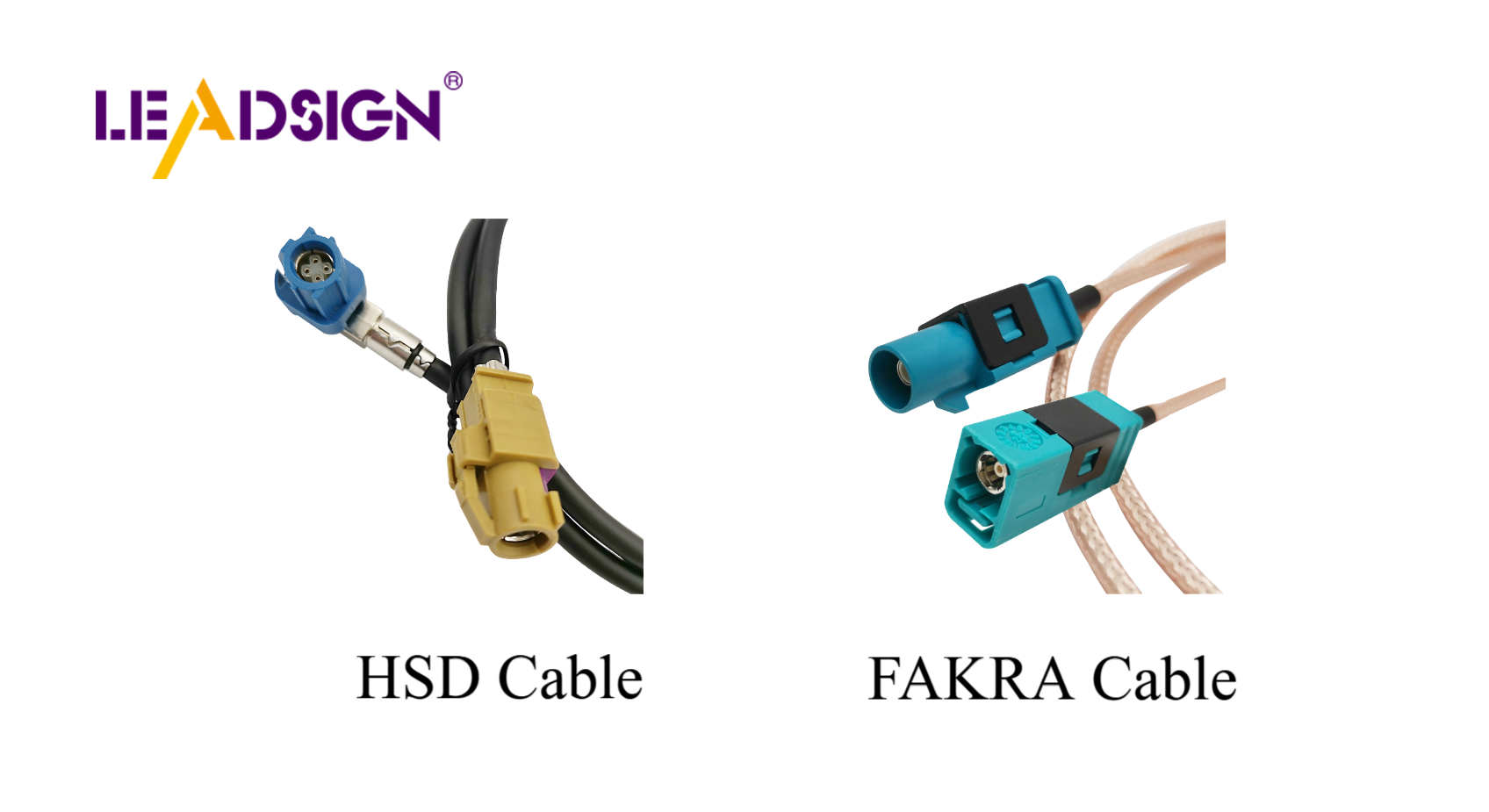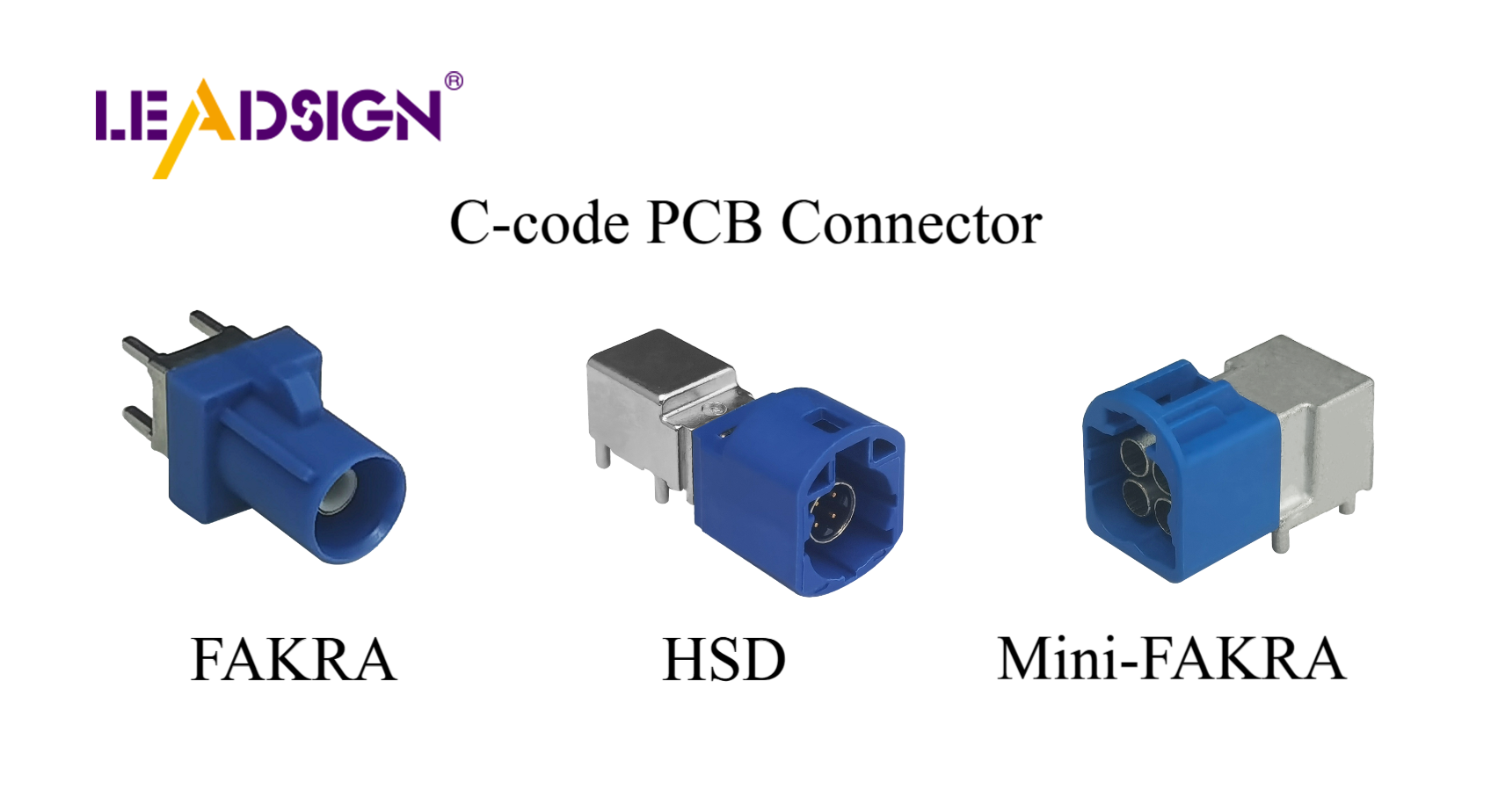HSD vs FAKRA Comparing Automotive Electrical Connectors Types

Comparing HSD and FAKRA Automotive Electrical Connectors
Explore the differences between HSD and FAKRA connectors in automotive applications.
Features | HSD | FAKRA |
|---|---|---|
Data Transfer Speed | Fast data transfer with LVDS technology | Designed for RF signal transmission |
Impedance Control | Impedance-controlled system for steady signals | Impedance of 50 Ω for RF signals |
Locking Mechanism | Primary and secondary lock for security | Double locking system for stability |
Applications | Used in infotainment, USB, and Ethernet systems | Ideal for GPS, radio antennas, and RF Bluetooth |
Durability | Built to withstand tough car conditions | Waterproof design for longevity |
Compatibility | Cross-manufacturer compatibility | Color-coded housings for easy setup |
Cost | Higher cost due to advanced features | Cost-effective design for RF applications |
HSD and FAKRA connectors are two important types of automotive electrical connectors used in cars, each serving distinct functions. HSD connectors excel in fast data transfer, utilizing LVDS technology to minimize interference, making them ideal for applications such as USB, Ethernet, and infotainment systems. On the other hand, FAKRA connectors are designed to manage RF signals, including GPS and radio communications. They are robust, feature secure locking mechanisms, and offer high precision. Together, these automotive electrical connectors types effectively meet the demands of modern vehicle systems.
Key Takeaways
HSD connectors are designed for high-speed data transfer, making them ideal for infotainment systems, USB, and Ethernet applications.
FAKRA connectors excel in transmitting RF signals, perfect for GPS, radio communications, and keyless entry systems.
Both connector types are built to withstand harsh automotive environments, with HSD connectors focusing on durability and interference prevention, while FAKRA connectors offer waterproof designs.
Choosing the right connector depends on your system's needs: opt for HSD for fast data and FAKRA for reliable RF signal transmission.
Consider cost and compatibility when selecting connectors; HSD connectors tend to be pricier due to their advanced features, while FAKRA connectors are more affordable and widely available.
Utilize the color-coded features of FAKRA connectors to avoid installation errors and ensure secure connections in your vehicle's systems.
Understanding the specific applications and limitations of each connector type can significantly enhance the performance and reliability of automotive systems.
Understanding HSD Connectors in Automotive Electrical Connectors Types

What are HSD Connectors?
HSD (High-Speed Data) connectors help send data quickly in cars. They use a special system to keep signals clear and steady. Their design blocks interference like EMI and crosstalk, keeping signals strong. These connectors work with shielded twisted quad cables for better performance. They are popular in cars because they are durable and handle tough conditions well.
Main Features of HSD Connectors
HSD connectors have useful features for car systems:
Impedance-Controlled System: Keeps signals steady and supports speeds up to 6 GHz.
Shielding Mechanism: Stops interference, keeping signals clear and reliable.
Coding Options: Different codes prevent wrong connections; Z-coding works with all.
Durability: Built to handle heat, cold, and shaking in cars.
Cross-Manufacturer Compatibility: Works with systems from different brands.
Versatile Design: Comes in straight or angled shapes for easy fitting.
These features make HSD connectors great for fast data transfer in cars.
How HSD Connectors Are Used in Cars
HSD connectors are important for many car systems needing fast data. They are used in:
Infotainment Systems: Send audio and video for entertainment.
Navigation and GPS: Help with accurate maps and directions.
Cameras and Sensors: Send data for cameras in safety systems.
USB Connectivity: Work with USB 1.0, 2.0, and 3.0 devices.
Ethernet Networks: Provide fast links for car networks.
Telematics: Help with tracking and car diagnostics.
IEEE 1394 (FireWire): Move multimedia data quickly.
HSD connectors are key in automotive electrical connectors types. They meet the need for fast data in modern cars. Their strong design and flexibility make them useful for many car systems.
Exploring FAKRA Connectors in Automotive Electrical Connectors Types
What are FAKRA Connectors?
FAKRA connectors are special RF connectors made for cars. They send RF signals reliably from DC to 6 GHz. These connectors use SMB technology for strong and secure connections. They connect coaxial cables with a male and female system. This design keeps signals clear and aligned. FAKRA connectors have color-coded covers to avoid wrong connections. Their tough build resists water and blocks interference. This makes them perfect for tough car environments.
Main Features of FAKRA Connectors
FAKRA connectors have many features that help car systems:
High-Frequency Capability: Works up to 6 GHz for steady RF signals.
Secure Locking Mechanism: Double locks keep connections stable.
Color-Coded Housings: 13 colors and one neutral prevent mix-ups.
Durability: Handles extreme heat, cold, and rough conditions.
Waterproof Design: Stops water damage for long-lasting use.
Versatile Configurations: Comes in different shapes for easy fitting.
Quick-Plug Design: Makes setup and repairs simple.
These features make FAKRA connectors great for sending RF signals in cars.
How FAKRA Connectors Are Used in Cars
FAKRA connectors are important for car systems needing RF signals. They are used in:
GPS and Navigation Systems: Sends signals for accurate maps and directions.
Radio Antennas: Helps with clear radio sound.
Infotainment Systems: Streams TV and multimedia in cars.
Mobile Communication: Connects to mobile networks like GSM.
RF Bluetooth and WLAN Applications: Supports wireless devices in cars.
Keyless Entry Systems: Sends signals for remote car unlocking.
Vehicle Sensors: Moves data from sensors for safety and detection.
FAKRA connectors are vital for car systems needing steady RF signals. Their strong build and flexible design make them a top choice for modern vehicles.
Key Differences Between HSD and FAKRA Connectors

Technical Specifications and Design
HSD and FAKRA connectors are built for different tasks. HSD connectors are made for fast data transfer. They have a 100-ohm system to keep signals steady. Their shielding stops interference like EMI and crosstalk. This makes them great for sending videos, images, and other big data. HSD connectors also have coding options to avoid wrong connections.
FAKRA connectors are coaxial connectors for RF signals. They work from DC to 6 GHz and lock securely for stable use. FAKRA connectors have 13 color codes and one neutral code. This helps with easy setup and prevents mistakes. They are waterproof and tough, so they last in harsh car conditions. HSD focuses on speed, while FAKRA handles RF signals well.
Performance and Data Transmission Capabilities
HSD connectors are best for fast and steady data transfer. They work well in systems like infotainment, Ethernet, and USB. Their shielding keeps signals clear and strong. HSD connectors are perfect for sending videos and images that need high precision.
FAKRA connectors are made for RF signals like GPS and radio. They send signals far without losing quality. While not as fast as HSD, they keep RF signals steady. This makes them great for communication and navigation systems. Both connectors play important roles in modern cars.
Compatibility with Automotive Systems
HSD and FAKRA connectors fit different car system needs. HSD connectors are used in systems needing fast data, like navigation and ADAS. They work with many brands and have flexible designs, making them reliable.
FAKRA connectors focus on RF signals for systems like GPS and keyless entry. Their color codes make setup simple and prevent errors. They come in different shapes, like straight or angled, for easy fitting. Together, these connectors meet the needs of car systems, ensuring they work well and last long.
Cost and Availability
The price and availability of HSD and FAKRA connectors depend on their design and use. Each type is made for specific car needs, which affects its cost and how easy it is to find.
HSD connectors are built for fast data transfer. They have special features like shielding and coding to work well in tough car systems. These advanced designs make them more expensive. They come in different shapes, which can slightly change their price. Even though they cost more, they are common in systems like infotainment, Ethernet, and ADAS. This keeps them easy to find in the market.
FAKRA connectors are made for sending RF signals and cost less than HSD connectors. Their simpler design focuses on RF uses like GPS and radios. This makes them cheaper to make. Their color-coded covers and flexible shapes help with easy production and delivery. Because of this, FAKRA connectors are affordable and widely available for car makers.
Key Insight: HSD connectors are pricier because they handle fast data. FAKRA connectors are cheaper and focus on reliable RF signals.
When picking one, car experts should think about their system's needs. For fast data, spending more on HSD connectors is worth it. For RF-based systems, FAKRA connectors are a good, low-cost choice. Both types are important and help cars meet modern tech needs.
Pros and Cons of HSD Connectors and FAKRA Connectors
Advantages of HSD Connectors
HSD connectors have many benefits for fast data in cars.
High-Speed Data Transmission: They send data quickly, up to 6 GHz. This helps systems like infotainment, Ethernet, and USB work smoothly.
Interference Prevention: LVDS technology stops signal problems like EMI and crosstalk. This keeps signals clear in busy car systems.
Cross-Manufacturer Compatibility: They fit with parts from different brands. This makes them easy to use in many cars.
Durability: Built tough, they handle heat, shaking, and tough conditions.
Coding Options: Different codes, like Z-coding, stop wrong connections. This makes setup safer and easier.
These features make HSD connectors great for fast, steady data in cars.
Disadvantages of HSD Connectors
HSD connectors have some downsides despite their many benefits.
Higher Cost: Their advanced design makes them more expensive than simpler connectors.
Complexity in Design: Making them takes time because of their detailed design.
Limited to High-Speed Applications: They work best for fast data but aren't ideal for slower systems.
Even with these issues, HSD connectors are still a top choice for modern cars.
Advantages of FAKRA Connectors
FAKRA connectors are great for systems needing RF signals.
Reliable RF Signal Transmission: They send RF signals well, up to 6 GHz. This is perfect for GPS, radios, and keyless entry.
Secure Locking Mechanism: Double locks keep connections strong and stable.
Color-Coded Housings: Colors help avoid mistakes during setup.
Cost-Effectiveness: They cost less because of their simple design.
Durability and Waterproofing: They resist heat, cold, and water, lasting a long time.
Versatile Configurations: Different shapes make them fit easily in various setups.
These features make FAKRA connectors a smart, affordable choice for RF-based systems.
Disadvantages of FAKRA Connectors
FAKRA connectors work well for RF signals, but they have limits.
Limited Data Speed: FAKRA connectors are made for RF signals, not fast data. They work up to 6 GHz but can't handle big files like videos. This makes them unsuitable for systems needing quick data transfer.
Narrow Use: FAKRA connectors are best for RF-based systems like GPS and radios. They don't work well with high-speed systems like Ethernet or USB. This limits their use in modern cars with many tech needs.
Hard to Install in Tight Spaces: FAKRA connectors have color codes for easy setup. But their coaxial design can be tricky in small spaces. Aligning and locking them takes more time in crowded systems.
Less Compatible with Fast Systems: HSD connectors work with many brands, but FAKRA connectors focus on RF signals. They don't fit well in systems needing both RF and fast data.
Key Insight: FAKRA connectors are great for RF signals but not for fast data. Car experts should check their system needs before choosing FAKRA connectors.
Picking the Best Connector for Your Car Systems
Choosing the right connector needs careful thought. Each type has a special job. Knowing their differences helps systems work well.
System Needs: Know what the system does. HSD connectors are great for fast data, like in-car entertainment and Ethernet. FAKRA connectors work better for communication, like GPS and radios.
Signal Type: Check if the system needs fast data or RF signals. HSD connectors handle tasks like video and Ethernet. FAKRA connectors are best for RF signals, like navigation and keyless entry.
Environment: Think about where the system works. Both connectors handle heat and shaking. But FAKRA connectors are waterproof, so they’re good for wet areas.
Cost: Look at the price. HSD connectors cost more because of their advanced design. FAKRA connectors are cheaper and good for RF-based systems.
Compatibility: Make sure the connector fits the system. HSD connectors work with many brands. FAKRA connectors have color codes for easy setup.
By thinking about these points, car experts can pick the best connector for their needs and budget.
HSD connectors are great for sending fast data in cars. They are used in systems like infotainment and Ethernet. FAKRA connectors are best for RF signals like GPS and radios. They also work well for keyless entry systems. Both types are made for specific car needs.
Key Insight: Choosing the right connector depends on speed, signal type, and system needs.
By learning about their features, car experts can choose wisely. This helps improve system performance and meet modern car demands.
FAQ
What makes HSD and FAKRA connectors different?
HSD connectors send data quickly, perfect for infotainment and USB. FAKRA connectors handle RF signals like GPS and radios. HSD connectors stop interference with shielding. FAKRA connectors use color codes and strong locks for easy use.
Which connector works best for infotainment systems?
HSD connectors are best for infotainment. They send data fast for clear audio and video. Their shielding keeps signals strong and free from interference.
Can FAKRA connectors send high-speed data?
FAKRA connectors are not made for fast data. They send RF signals up to 6 GHz but lack features for big data or fast systems like USB.
Are HSD connectors good for RF systems?
HSD connectors are not built for RF systems. They focus on fast data and don’t have the design or range needed for RF signals.
Which connector costs less?
FAKRA connectors cost less because they are simpler. HSD connectors are pricier due to their advanced features. The choice depends on system needs.
How do their locking systems differ?
HSD connectors use codes to avoid wrong connections. FAKRA connectors have double locks for extra stability in tough conditions.
What should you think about when choosing a connector?
Think about signal type, system needs, and cost. HSD connectors are great for fast data. FAKRA connectors work well for RF signals. Durability and budget also matter.
Are both connectors tough enough for cars?
Yes, both are strong for car use. HSD connectors resist heat and shaking. FAKRA connectors are waterproof and built for outdoor use.
Can these connectors replace each other?
No, they can’t. HSD connectors are for fast data. FAKRA connectors are for RF signals. Each has a specific job.
What’s next for HSD and FAKRA connectors?
HSD connectors will grow with more data-driven car systems. FAKRA connectors will stay key for RF uses like navigation. Both will improve as car tech advances.
See Also
Why Fakra Connectors Matter in Today's Automotive Sector
Understanding the Advantages of Fakra Connectors for Vehicles
An Introduction to HSD Connectors in Automotive Applications

